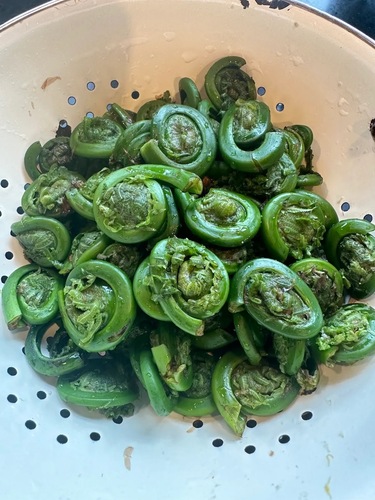From my youngest childhood days, I remember foraging for fiddlehead ferns with my Uncle Leonard, a great forager of wild native foods. Heading out to the woods with him and my Aunt Mary was always a treat; she searched for antique bottles around old cellar holes, while he turned his attention to wild foods.
In the spring, Uncle Leonard gathered fiddleheads along with the fragrant ramps (wild leeks) that grew in great abundance and, when we were lucky, morel mushrooms.
Fiddleheads appear for only a few weeks. Before they become the beautiful fronds of the ostrich ferns that green our woodlands, they can grace your table. They are delicious, extremely nutritious, and unlike any other green.
My uncle called ramps "wild leeks," but others call them "wild garlic," because of their strong smell. They are delicious sautéed in butter and served with potatoes. We love them.
* * *
I usually get my fiddleheads at the farmstand these days or from the forager who sells them from his truck parked on the side of the road. They can be a springtime delicacy, but you absolutely have to prep them correctly, or you will never take a second bite.
Fiddleheads need to be soaked to remove their dried brown scales, then blanched to remove the extremely bitter tannins. The blanching water will turn English Breakfast Tea dark brown when you are finished, and that means the bitterness has been removed. Cook them quickly after that, a simple sauté or warming in a dish like this pasta. (See sidebar.)
A bit tedious, yes, but not difficult.
* * *
Don't worry, there are substitutions.
If the season is over for you, or if you don't have them in your area, substitute chopped asparagus for the fiddleheads and another leek for the ramps, adding a couple of cloves of garlic. The dish won't taste quite the same, but it will still be delicious.
Put the pasta water on to boil, and you will be almost there
This dish takes a bit of prep, but after the fiddleheads are blanched, it can happen in the time it takes the pasta to cook. I usually prep a big mess of fiddleheads and use them over the next few days on multiple dishes - then making it would be much less work.
If you want to make this dish vegetarian, simply omit the anchovies.
Spring Supper of Penne with Fiddleheads and Ramps
¶1 leek, white and light-to-medium green, sliced
¶1 bunch (10 ounces) of ramps
¶ ¼ cup extra virgin olive oil
¶6 anchovy filets, minced
¶2 medium-sized tomatoes, chopped
¶2 cups prepared fiddlehead ferns
¶Juice and zest of 1 lemon
¶12 oz. brown rice or whole wheat penne or pasta of choice
¶⅓ cup Parmesan cheese, freshly grated
¶¼ cup chopped hazelnuts for a little crunch
Put the water on to boil for the pasta and to blanch the ramp leaves.
Cut the bulbs from the ramps and dice them. Set the tops aside.
Slice the white and most of the green of the leeks, leaving only the darkest, toughest leaves. They are often quite dirty, so give them a good wash once they are cut. Chop the tomato and mince the anchovies.
Once the water is boiling, salt it and add the ramp tops and blanch them for 10 seconds, no more, only until you have softened them and the green color has set. Put them in a food processor, and immediately add the pasta to the same water.
Meanwhile, in a large skillet, heat the olive oil over medium and add the leeks, ramp bulbs, and anchovies. Sauté until the leeks are soft and anchovies have just about disappeared. Toss in the tomatoes and the fiddleheads and let cook until these are warmed through. Shut off the heat.
Pulse the ramp tops in the food processor and add the lemon juice and zest and the purée. Add that to the pot of vegetables and mix well.
If you do not have a food processor, very finely mince the leaves, or pulverize them with a mortar and pestle. Then combine the leaves with the vegetables.
Once the pasta is cooked, reserve 1 cup of the water and drain. Add to the rest of the ingredients along with ⅓ cup or so of the pasta water, and ⅓ cup grated Parmesan cheese.
Combine everything well, and add a bit more water if you think it needs it.
Place on a large platter and top with a drizzle more of olive oil, the nuts, a bit of parsley if you have it, and a little more Parmesan. The wild taste of spring!
Any leftovers of this dish can easily be transformed into a pasta salad. Just add your favorite vinaigrette, mix it well, and enjoy on a bed of lettuce. Fantastic!
Dorothy Grover-Read's culinary talents can be found on her blog "The New Vintage Kitchen" (vintagekitchen.org), billed as "[a] Vermont innkeeper's collection of classics reimagined for today's kitchen," from which this week's recipes have been gleaned. Her column has regularly appeared in The Commons' Food & Drink and other special sections for years.
This Special section column was submitted to The Commons.
